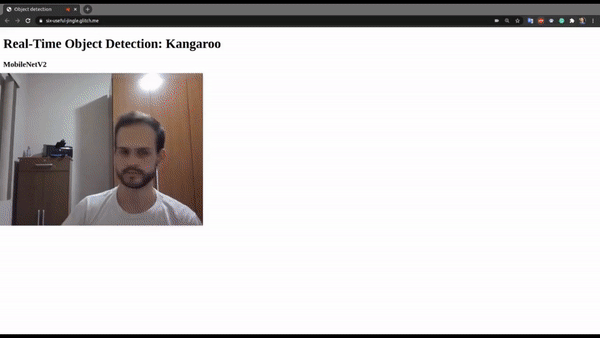This repository is part of the tutorial Custom real-time object detection in the browser using TensorFlow.js. For a better understanding of how to create a custom object detection model, refer to the post.
This project is a simple web-app that loads a model in the TensorFlow.js layers format using javascript and performs real-time inferences ingesting videos from a PC or mobile camera.
A Kangaroo detector was trained as a demo, but any object can be recognized following the tutorial steps and it will produce results similar to the shown below:
A live demo is available on Glitch:
The model saved at models/kangaroo-detector was trained using the kangaroo-dataset available on kaggle:

You can train your own model, upload it in the model folder and load as well.
To make the model available, it is necessary to define how the model is going to be loaded in the function load_model (lines 10–15 in the file src>index.js). There are two choices.
The first option is to create an HTTP server locally that will make the model available in a URL allowing requests and be treated as a REST API. When loading the model, TensorFlow.js will do the following requests:
GET /model.json
GET /group1-shard1of5.bin
GET /group1-shard2of5.bin
GET /group1-shard3of5.bin
GET /group1-shardo4f5.bin
GET /group1-shardo5f5.bin
If you choose this option, define the load_model function as follows:
async function load_model() {
// It's possible to load the model locally or from a repo
const model = await loadGraphModel("http://127.0.0.1:8080/model.json");
//const model = await loadGraphModel("https://raw.githubusercontent.com/hugozanini/TFJS-object-detection/master/models/kangaroo-detector/model.json");
return model;
}Then install the http-server:
npm install http-server -g
Go to models > kangaroo-detector and run the command below to make the model available at http://127.0.0.1:8080 . This a good choice when you want to keep the model weights in a safe place and control who can request inferences to it.
http-server -c1 --cors .
The second option is to upload the model files somewhere, in my case, I chose my own Github repo and referenced to the model.json URL in the load_model function:
homepage.png
async function load_model() {
// It's possible to load the model locally or from a repo
//const model = await loadGraphModel("http://127.0.0.1:8080/model.json");
const model = await loadGraphModel("https://raw.githubusercontent.com/hugozanini/TFJS-object-detection/master/models/kangaroo-detector/model.json");
return model;
}This is a good option because it gives more flexibility to the application and makes it easier to run on some platform as Glitch.
To run the app locally, install the required packages:
npm install
And start:
npm start
The application is going to run at [http://localhost:3000](http://localhost:3000) and you should see something similar to this:
The model takes from 1 to 2 seconds to load and, after that, you can show the objects images to the camera and the application is going to draw bounding boxes around them.

